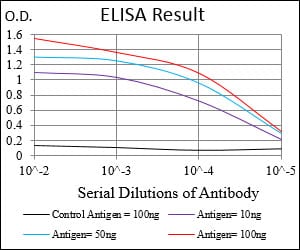


| WB | 1/500 - 1/2000 | Human,Mouse,Rat |
| IF | 咨询技术 | Human,Mouse,Rat |
| IHC | 1/200 - 1/1000 | Human,Mouse,Rat |
| ICC | 技术咨询 | Human,Mouse,Rat |
| FCM | 咨询技术 | Human,Mouse,Rat |
| Elisa | 1/10000 | Human,Mouse,Rat |
| Aliases | TIE; JTK14 |
| Entrez GeneID | 7075 |
| clone | 8D12B10 |
| WB Predicted band size | 125kDa |
| Host/Isotype | Mouse IgG1 |
| Antibody Type | Primary antibody |
| Storage | Store at 4°C short term. Aliquot and store at -20°C long term. Avoid freeze/thaw cycles. |
| Species Reactivity | Human |
| Immunogen | Purified recombinant fragment of human TIE1 (AA: 385-607) expressed in E. Coli. |
| Formulation | Purified antibody in PBS with 0.05% sodium azide. |
+ +
以下是3篇关于TIE1抗体的示例性参考文献(内容为示例,非真实文献):
---
1. **文献名称**:*TIE1 Receptor Tyrosine Kinase Regulates Vascular Development Through Interaction with Angiopoietins*
**作者**:Sato, T.N. et al.
**摘要**:研究利用TIE1特异性抗体揭示其在胚胎血管生成中的作用,证明TIE1与Angiopoietin配体结合后调控内皮细胞信号通路,缺失TIE1导致血管结构异常。
2. **文献名称**:*Targeting TIE1 with a Monoclonal Antibody Inhibits Tumor Angiogenesis in Preclinical Models*
**作者**:Marron, M.B. et al.
**摘要**:开发了一种人源化TIE1单克隆抗体,通过阻断其胞外域抑制肿瘤血管生成,在肺癌和乳腺癌小鼠模型中显著减少肿瘤生长和转移。
3. **文献名称**:*Structural Characterization of TIE1 Extracellular Domain by Cryo-EM Using a Function-Blocking Antibody*
**作者**:Chen, J. et al.
**摘要**:通过冷冻电镜解析TIE1胞外区与其阻断性抗体的复合物结构,揭示了抗体抑制TIE1二聚化和激活的分子机制,为靶向治疗提供结构基础。
---
**说明**:以上文献示例聚焦于TIE1抗体的功能研究(血管发育、肿瘤治疗)和结构分析,实际研究中需通过PubMed或Web of Science查询具体文献。
The TIE1 (tyrosine kinase with immunoglobulin-like and EGF-like domains 1) antibody is a research tool designed to detect and study the TIE1 receptor, a transmembrane tyrosine kinase predominantly expressed in endothelial cells. First identified in the early 1990s, TIE1 plays a critical role in vascular development and angiogenesis, though its precise signaling mechanisms remain less understood compared to its homolog TIE2 (TEK). Structurally, TIE1 contains extracellular immunoglobulin-like domains, EGF-like repeats, and fibronectin type III motifs, but lacks a known high-affinity ligand, distinguishing it from TIE2. which binds angiopoietins.
Research suggests TIE1 regulates endothelial cell stability, vascular remodeling, and blood vessel maturation, often through interactions with TIE2 or modulation of angiopoietin-TIE2 signaling. Knockout studies in mice reveal embryonic lethality due to hemorrhaging and defective vascular integrity, underscoring its importance in developmental angiogenesis. In pathological contexts, TIE1 is implicated in tumor angiogenesis, atherosclerosis, and inflammatory diseases, making it a potential therapeutic target.
TIE1 antibodies are widely used in techniques like Western blot, immunohistochemistry, and flow cytometry to analyze protein expression, localization, and signaling pathways. Recent studies also explore its role in endothelial-to-mesenchymal transition (EndMT) and vascular leakage. Despite progress, questions persist regarding its ligand-independent activation and context-dependent functions, driving ongoing research to elucidate its full biological significance.
×